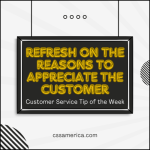The best customer service professionals are also excellent educators. Not only within the organization, but I’m talking specifically about the role they play as educator with their customers. With all the self-service options that technology provides, customers often have the opportunity to do things on their own, to investigate on their own, to address issues on their own.
Unfortunately, technology is not always self-evident. It doesn’t always think like customers think. It doesn’t often convey what the customer needs to know when they need to know it in a way that the customer can absorb, understand, and use moving forward.
So, if we want to be the best of customer service professionals, we need to be excellent educators.
Let’s say we have a customer named Christopher. About what do we need to build Christopher’s awareness? What does Christopher need to know to get things done? What knowledge does Christopher need to build in order to have the best experience possible with our organization?
Ask yourself (or your customers) these types of questions, because these questions build your understanding of what content is required in your educational endeavors with customers.
Does Christopher need to be more aware of technology options such as mobile apps, self-service website functions, chat functions, automated phone options? And does he need to know how to navigate those mechanisms? Does he need to know how to place in order, how to check status, how to follow-up directly with the right person, how to see if a service is completed or a delivery has been made? Does Christopher need to know the services available, the features available, the different ways to experience your product or your service, your event or your facility?
To strengthen your role as an educator of customers, first identify what the key content is where they need to be more knowledgeable or better trained.
Identify what THEY need to know in order to have the best experience possible.
Signup for FREE Tips! Contact Us More Resources for You Visit Our Home Page
















 Here are 3 customer service scenarios for a college IT department:
Here are 3 customer service scenarios for a college IT department:






